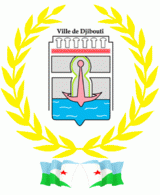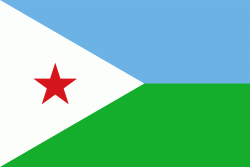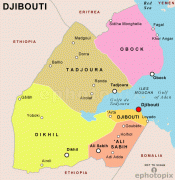Djibouti (Djibouti)
 |
Djibouti has a population of around 600,000 inhabitants, which counts for 54% of the country's population. The settlement was founded in 1888 by the French, on land leased from the ruling Somali and Afar Sultans. During the ensuing period, it served as the capital of French Somaliland and its successor the French Territory of the Afars and Issas.
Known as the Pearl of the Gulf of Tadjoura due to its location, Djibouti is strategically positioned near the world's busiest shipping lanes and acts as a refueling and transshipment center. The Port of Djibouti is the principal maritime port for imports to and exports from neighboring Ethiopia. Djibouti-Ambouli International Airport is the main domestic airport, connecting the capital to various major global destinations. Djibouti has the second-largest economy of any city in the Horn of Africa after Addis Ababa.
There is evidence of human settlement on the eastern coastline of Djibouti dating back to the Bronze Age.
From 1862 until 1894, the land to the north of the Gulf of Tadjoura was called Obock and was ruled by Issa and Afar Sultans, local authorities with whom France signed various treaties between 1883 and 1887 to first gain a foothold in the region. The exchange of Franco-British diplomatic notes of 2 and 9 February 1888 fixed the territorial limit between the colonies of the two countries; leaving explicitly under French authority the southern coasts of the Gulf of Tadjoura, including a peninsula composed of insubmersible plateaux, Ras Djibouti as a highly strategic location, a future bridgehead for French designs in the rest of Africa and Asia. It is then that this point begins to be used as departure for caravans towards Harar.
The French subsequently founded Djibouti in 1888, in a previously uninhabited stretch of coast. According to one account, this was due to "its superiority to Obok both in respect to harbour accommodation and in nearness to Harrar." Ambouli was a small village before the French arrived it was about 3 km south of Ras Djiboutil, Ambouli is identifies the city with Canbala by O.G.S. Crawford. Canbala appears in Muhammad al-Idrisi's map of 1192 on the coast of the Horn of Africa, southeast of the straits of Bab-el-Mandeb, and with Cambaleh, a town where the Venetian traveler Bragadino, a thirteenth-century European visitor to Ethiopia, resided for eight years. In 1896, the settlement was made the capital of French Somaliland. The main purpose of the French interest in colonizing the region was to protect their trade routes to Madagascar and Indochina from the encroachment of other European powers. The town later grew considerably in size following the construction of the Franco-Ethiopian Railway. In 1895, Djibouti, which, not so long ago, was just a peninsula, already had 5,000 inhabitants. Many Issa and Afar nomads left their herds to settle here, built houses on what is now the downtown area. They became dockers and constitute the first local proletariat. The French and natives built hotels, houses, mosques and churches. The Yemeni, Egyptian, Greek, Armenian and Italian merchants and traders flock to this promise that Djibouti represents. Additionally, the rich agricultural southern area of Ambouli continued to flourish due to an abundance of date palm farms and Orchards. Djibouti did not attract as many boats as Aden. In 1896, Léonce Lagarde became the first governor of the French Somali Coast, a new name for the French dependencies in the region. At the start of the 20th century, Djibouti had 10,000 inhabitants and was considered a major regional port. Its main activity remains the supply of French ships en route to Indochina or Madagascar. Only 150,000 tonnes of freight per year are handled. In addition, the railway line has not yet been fully exploited.
Although the initial French efforts to establish commercial influence in the region proved to be unsuccessful enough to require a government bailout, the Franco-Ethiopian Railway itself was a success and allowed Djibouti's commerce to quickly eclipse the former caravan-based trade carried on with nearby Zeila in British Somaliland. Djibouti became the center of exports from southern Ethiopia and the Ogaden, including trade in Harari coffee and khat. Djibouti began to develop as a commercial center. In 1933, Djibouti was the first town to be wired to electricity in French Somaliland. On 12 July 1926, the Fontainebleau, a Messageries Maritimes steamer loaded with cotton and heading for China caught fire while approaching Djibouti. The captain decides to flood the holds and run aground his ship in the middle of the harbor of Djibouti. The inconvenience will be significant for the port traffic. But we then decided to use the wreck as a promontory of a new deep-water port, connecting it to the Marabout plateau by a 700 m jetty. The brilliant idea was accepted and work began in 1931. The first phase was completed in 1935 and considerably increased port and rail traffic. An oil terminal was built in 1937.
During the Second World War, Djibouti was hit by Italian airstrikes on 21 June 1940, which killed many people in the town. The anti-aircraft fire was intense and two Italian aircraft failed to return, but fires and explosions were seen in Djibouti. Overnight, several waves of Savoia-Marchetti SM.81 bombers attacked the port facilities. After the France fell and the colony was then ruled by the pro-Axis Vichy (French) government. By that time, the Allied offensive against the Italians included a blockade of French Somaliland. On 25 September the RAF launched several airstrikes on the city, prompting French official Nouailhetas to institute a brutal reign of terror against Europeans and African inhabitants of the city. Famine set in malnutrition-related diseases took many lives, 70% of them women and children and many townsfolk left for the hinterland. The locals named the blockade the carmii, a word for a type of sorghum usually reserved for cattle, but used as human food at the height of the famine. The head doctor at the hospital committed suicide in despair. Only a few Arab dhows (boutres) managed to run the blockade to Djibouti and Obock and only two French ships from Madagascar managed to run it. The Japanese declaration of war (7 December 1941) gave the colony some respite, since the Royal Navy were forced to withdraw all but two ships from the blockade for use in the Far East. The rule of Nouailhetas was too brutal for even the authoritarian leaders at Vichy to stand for. In October 1942 he was recalled and forced to retire without a pension, Following the war, he escaped to Portugal. He returned to face a military tribunal and was acquitted on 17 July 1953, which sparked outrage in Djibouti. The Commander-in-Chief, East Africa, William Platt, codenamed the negotiations for the surrender of French Somaliland "Pentagon", because there were five sides: himself, the Vichy governor, the Free French, the British minister at Addis Ababa and the United States. Christian Raimond Dupont surrendered and Colonel Raynal's troops crossed back into French Somaliland on 26 December 1942, completing its liberation. The official handover took place at 10:00 p.m. on 28 December. The first governor appointed under the Free French was André Bayardelle.
In 1946, Djibouti received the status of overseas territory. An elected territorial assembly was created then, in 1956, a government council charged, under the chairmanship of the head of the territory, with the management of local affairs. At the same time, fiscal, customs and monetary measures are put in place to promote the development of the deep-water port, to finally compete with Aden. Port facilities are expanding considerably and can afford to accommodate 2,000 ships per year. Djibouti becomes a free port and abandons the free zone. In 1948, a new currency, the Côte Française des Somalis, was created, pegged to the gold standard and convertible into dollars.
In August 1966, an official visit to the territory by then French President, General Charles de Gaulle, was also met with demonstrations and rioting. In response to the protests, de Gaulle ordered another referendum. On 19 March 1967, a second plebiscite was held to determine the fate of the territory. Initial results supported a continued but looser relationship with France. However, the referendum was again marred by reports of vote rigging on the part of the French authorities, voters rejected independence by a 50-point margin. Announcement of the plebiscite results sparked civil unrest, including several deaths.
Map - Djibouti (Djibouti)
Map
Country - Djibouti
 |
 |
| Flag of Djibouti | |
In antiquity, the territory, together with Ethiopia, Eritrea and Somaliland, was part of the Land of Punt. Nearby Zeila, now in Somaliland, was the seat of the medieval Adal and Ifat Sultanates. In the late 19th century, the colony of French Somaliland was established after the ruling Dir Somali sultans signed treaties with the French, and its railroad to Dire Dawa (and later Addis Ababa) allowed it to quickly supersede Zeila as the port for southern Ethiopia and the Ogaden. It was renamed the French Territory of the Afars and the Issas in 1967. A decade later, the Djiboutian people voted for independence. This officially marked the establishment of the Republic of Djibouti, named after its capital city. The new state joined the United Nations. In the early 1990s, tensions over government representation led to armed conflict, which ended in a power-sharing agreement in 2000 between the ruling party and the opposition.
Currency / Language
| ISO | Currency | Symbol | Significant figures |
|---|---|---|---|
| DJF | Djiboutian franc | Fr | 0 |
| ISO | Language |
|---|---|
| AA | Afar language |
| AR | Arabic language |
| FR | French language |
| SO | Somali language |






